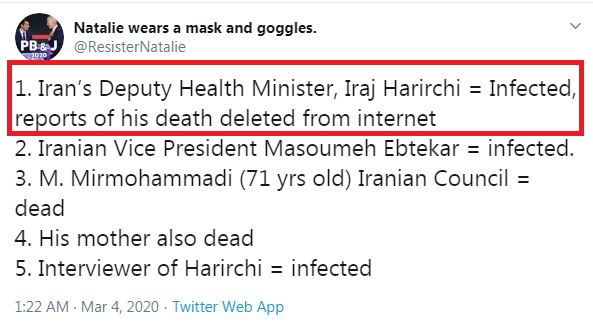Iran's deputy health minister, Iraj Harirchi had tested positive for the Novel Coronavirus a few days ago and since then he was under strict observation. But recently a Tweet claimed that the minister has died of COVID-19 which has killed 92 Iranians and infected, while the number of those infected reached 2,822 people.
Iraj Harirchi and an MP both have tested positive for the new coronavirus. The health minister announced on February 25 that he had tested positive for the COVID-19. Later a video appeared where the health minister confirmed the news.
So, the guy sweating profusely on left is Iraj Harirchi, #Iran Deputy Health Minister, insisting they have the #coronavirus under control. The video was from yesterday. Today, it has been confirmed that he now has the corona virus himself.
— Arsen Ostrovsky (@Ostrov_A) February 25, 2020
I wonder if he briefed @khamenei_ir? pic.twitter.com/h2CPQ1r7wx
During a press conference, which took place on February 24, Iraj Harirchi stood at the podium to brief the media on the outbreak in Iran. Later, he noticed himself sweating and looked surprised. He grabbed a handkerchief and proceeded to dab at his forehead as the minister for cooperatives, labour and social welfare, Ali Rabiei continued to talk at the press meet.
Is Iran Deputy health minister dead?

On Wednesday, March 4, a Tweet by Natalie wears a mask and goggles claimed that the Iraj Harirchi has died of Coronavirus but all the reports were deleted from internet. The Tweet reads, "Iran's Deputy Health Minister, Iraj Harirchi = Infected, reports of his death deleted from internet."
It also added that Iranian Vice President Masoumeh Ebtekar and an interviewer of Harirchi was infected by the new Coronavirus. The Tweet added, "M. Mirmohammadi (71 yrs old) Iranian Council = dead 4. His mother also dead."

As of now, the Tweet has received only two retweets. But it should be mentioned that based on the location mentioned on the Twitter handle, the operator is not an Iran based netizen, as the location shows California, US.
(Disclaimer: IBTimes Singapore would not independently verify the source of this story.)









